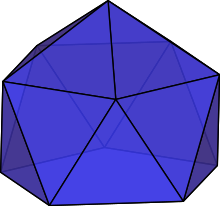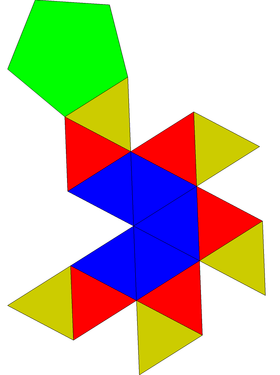|
Gyroelongated pentagonal pyramid
 In geometry, the gyroelongated pentagonal pyramid is a polyhedron constructed by attaching a pentagonal antiprism to the base of a pentagonal pyramid. An alternative name is diminished icosahedron because it can be constructed by removing a pentagonal pyramid from a regular icosahedron. ConstructionThe gyroelongated pentagonal pyramid can be constructed from a pentagonal antiprism by attaching a pentagonal pyramid onto its pentagonal face.[1] This pyramid covers the pentagonal faces, so the resulting polyhedron has 15 equilateral triangles and 1 regular pentagon as its faces.[2] Another way to construct it is started from the regular icosahedron by cutting off one of two pentagonal pyramids, a process known as diminishment; for this reason, it is also called the diminished icosahedron.[3] Because the resulting polyhedron has the property of convexity and its faces are regular polygons, the gyroelongated pentagonal pyramid is a Johnson solid, enumerated as the 11th Johnson solid .[4] PropertiesThe surface area of a gyroelongated pentagonal pyramid can be obtained by summing the area of 15 equilateral triangles and 1 regular pentagon. Its volume can be ascertained either by slicing it off into both a pentagonal antiprism and a pentagonal pyramid, after which adding them up; or by subtracting the volume of a regular icosahedron to a pentagonal pyramid. With edge length , they are:[2] It has the same three-dimensional symmetry group as the pentagonal pyramid: the cyclic group of order 10. Its dihedral angle can be obtained by involving the angle of a pentagonal antiprism and pentagonal pyramid: its dihedral angle between triangle-to-pentagon is the pentagonal antiprism's angle between that 100.8°, and its dihedral angle between triangle-to-triangle is the pentagonal pyramid's angle 138.2°.[5] See alsoReferences
External linksInformation related to Gyroelongated pentagonal pyramid |
||||||||||||||||||||||







